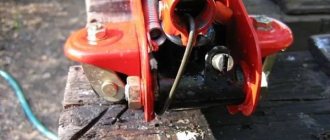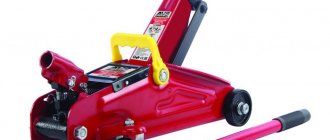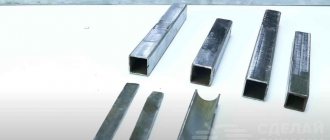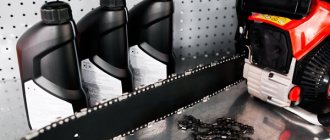Hydraulic jacks have become quite widespread. They can be used to lift various heavy loads. The operating principle of the design determines that the required pressure is created by supplying special oil to the working chamber. Periodic maintenance includes changing the oil in the hydraulic jack, as over time it can lose its properties. That is why you need to pay attention to what characteristics oil for hydraulic jacks should have.
Hydraulic oil requirements
Almost all oils for lifting structures are made from base hydraulic fluids, which are obtained by processing petroleum fractions. Oil for hydraulic rolling jacks is characterized by the presence of various additives, which significantly improve performance characteristics. Among other features, we note the following points:
- The viscosity should be slightly above average. If a substance is too thin or viscous, it may impede the movement of major parts. Checking viscosity is quite difficult. As a rule, this parameter is indicated by the manufacturer on the packaging. Over time, the viscosity of the oil decreases. That is why it has to be replaced periodically.
- The degree of filtration is another of the most important parameters. Filters are often installed in the design of the lifting mechanism, which reduce the likelihood of contaminants entering the working chamber. If the substance foams a lot, then a fairly large number of serious problems may arise. It is almost impossible to check the degree of filtration. That is why it is recommended to purchase products from well-known manufacturers that will have the required qualities.
- Don't forget about the anti-corrosion properties. The working chamber should be lubricated with oil to reduce the likelihood of rust. Even minor pieces of rust can seriously impede the movement of the rod. In addition, it is recommended to periodically pump the structure to eliminate the likelihood of corrosion during long periods of inactivity.
- The operating temperature range is also of great importance. Jack oil is manufactured to be suitable for low or high temperature applications. An example is the case when the device is used to service a vehicle on the road. Some substances change their basic properties when the temperature decreases or increases. Manufacturers indicate the recommended operating temperature range on the packaging.
- The viscosity index must be high.
Some of the above characteristics are indicated by the manufacturer on the packaging.
Tips for choosing oil
A fairly common question is what kind of oil is poured into a hydraulic jack. There are several varieties on sale:
- Glycolic.
- Petroleum or mineral.
- Synthetic.
Synthetic fluids are most widespread. They are characterized by increased safety, since production involves a complex technological process. Glycol versions are also common, the chemical composition of which determines high performance characteristics. In terms of price and quality, glycols outperform almost all others.
The cheapest option is petroleum or mineral oils. However, before pouring them into a rolling jack, it is worth taking into account the relatively low performance characteristics.
In some cases, used engine oil is refilled. It is necessary to use special oil, as it ensures long-term operation of the device. The lubricant should be changed at the moment when the device begins to work incorrectly.
How to change the oil in a jack
A sign that the oil in the hydraulic jack needs to be changed is the slow rise and fall of the device. It is worth considering that liquid may leak if the device is transported incorrectly. In a horizontal position in a hydraulic device, liquid flows to the valves, after which it begins to flow out. The place of the working fluid is taken by air, which significantly reduces the efficiency of the structure.
When considering how to fill a bottle jack, you need to pay attention to the following points:
- Before replacing the working fluid, it is recommended to disassemble the structure. This is due to the fact that it is necessary to thoroughly clean the piston from dirt and corrosion. Such substances can cause structural damage. On sale there are hydraulic jacks of collapsible or non-dismountable type. The first is characterized by the fact that all elements can be disassembled if desired. As a rule, it is enough to remove the rod with the piston
- In some cases, the gasket is replaced. It is worth considering the fact that damage to the sealing elements is not always noticeable. An example is a change in the stiffness index. You can find all seals on sale or restore the condition of old ones, provided there are no serious mechanical damages. To do this, you can use ammonia, in which the sealing elements are soaked. After a short treatment, the rubber regains its elasticity and provides the required level of insulation.
- Filling of oil into the hydraulic jack is carried out through a special connector. The plug is usually attached to a thread. When replacing the substance, the structure is pumped, since air can significantly reduce the efficiency of the lifting mechanism. It is recommended to pump several times, as air bubbles are difficult to remove.
Recommendations
It is well known that the key to long-term and full functioning of any mechanism, regardless of its purpose, is competent operation and timely, high-quality maintenance. That is why motorists are advised to know how to properly bleed a car hydraulic jack with their own hands. This will maximize the service life of the equipment and ensure the safety of work using it.
Operating rules for hydraulic jacks, including safety precautions, are developed taking into account the many years of experience of tool manufacturers
It is necessary to pay attention to the following important points:
- Frequent overloads and lifting to maximum heights lead to inevitable equipment failure. Curvature of the rod inevitably leads to air penetration, and pumping in such cases will be useless.
- The jack itself must be installed on a hard, as level surface as possible. Similar requirements apply to the point of emphasis on a lifted car or other load.
- When lowering, it is necessary to smoothly unscrew the bypass valve exactly one turn, otherwise the working fluid will move too quickly between the compartments, which will cause the load to be lowered jerkily, and will also increase the risk of airing.
- Proper transportation of the lift will help prevent the need for pumping. Bottle and rhombic hydraulic jacks should be transported in a vertical position, and with a rolling structure - in a horizontal position.
- The care of the moving parts of the device deserves special attention. This means, first of all, eliminating the risk of corrosion on mirror surfaces, which negatively affects the performance of the equipment.
It is important to remember that pumping hydraulic jacks is also a preventative measure. Often it allows you to prevent serious damage, and, therefore, avoid expensive repairs or the purchase of a new lift.
This means that it is recommended to pump the jacks periodically. In this case, the frequency and number of pumpings is determined by the intensity of use of the jack.
So, at a service station, a similar procedure is repeated at least monthly. For garage, rare use, it will be enough to pump it several times a year. Unscheduled maintenance may be required in the following cases:
- The presence of a large number of foreign particles in the liquid. Such impurities can significantly reduce the efficiency of jacks.
- The formation of bubbles, indicating a violation of the tightness and airiness of the hydraulic system.
- A sharp and significant reduction in working load capacity. As soon as the equipment stops lifting the loads declared by the manufacturer, the cylinders should be bled.
Many modern jacks are of one-piece construction. This means that it is not always possible to overhaul the device. In such situations, the optimal solution would be to pump the mechanism.
A more detailed overview of pumping a hydraulic jack is presented in the following video.
Hydraulic fluid in a jack - why is oil better?
The robust design and special weight distribution on the lever and inside the jack, as well as its hydraulic basis, make it much easier for a person to work with large and bulky loads. With the help of such a jack, for example, you can lift an entire truck or container with cargo, as well as a small platform.
As already mentioned, the main working element of the jack is hydraulic fluid, which is poured inside into a sealed container. It allows you to lift loads of almost any weight, depending on the properties. There are several types of fluid that are poured into a hydraulic jack, each of them has its own characteristics.
Typically, special oils are used as hydraulic fluid, which can be purchased at any automotive store:
- Some engine lubricant manufacturers offer branded hydraulic fluids for truck and car hydraulic systems that can be used not only in the brake and lift systems, but also in the jack.
- In addition, you can also use conventional industrial types of industrial oil (I12A, I20A, I30A, I40A, I50A). Although the last three types of oil should be used carefully, since they are too viscous and therefore may not be suitable for specific types of jacks. In addition, due to excessive hygroscopicity, they can cause damage to the jack, causing corrosion processes in metals.
- It is also worth understanding that brake fluid is only partially suitable for a hydraulic jack, because it is also too hygroscopic. As a result, water will cause damage to the jack, also causing corrosion processes.
Table 4. Operating oil replacement rates
| Options | Replacement rate indicators | |
| Viscosity change (at 40°C) | Conventional equipment +15% (Precision equipment +10%) | |
| Increase in acid number | More than 0.5 mgKOH/g. | |
| Water (% by volume) | 0.1 | |
| Presence of impurities (specific gravity in a microporous filter, mg/100 ml. at 0.45 μ) | Over 20 mg. (for precision equipment – over 10 mg.) | |
| Insoluble fractions (% by weight) | Benzene fraction | 0.05 |
| Pentane fraction | 0.10 | |
Hydraulic equipment requires periodic cleaning, which involves flushing and cleaning the pipe system to remove foreign substances and sediments from them. In this case, partial or complete dismantling of the pipeline is carried out during the period of oil change or pipe installation. For cleaning, a special purge (flushing) oil is used.
How to choose oil for a hydraulic jack?
In order to determine the type of oil that will then be poured into the hydraulic jack, you should understand some of the differences between the different groups of these lifts before filling them with oil.
Hydraulic jacks, depending on the design features, are divided into the following groups:
- bottle jacks;
- rolling jacks;
- toe jacks.
Depending on the group and design, each jack has its own maximum lift, which requires the maximum level of compression from the hydraulic fluid.
Are you here
High-quality oil for hydraulic jacks is the key to reliable and reliable service of the unit for many years. A properly selected composition will significantly reduce wear, ensuring the most efficient operation of the equipment.
Several types of oils have been developed:
- motor;
- flushing;
- transmission;
- hydraulic.
A certain type of product is designed for use for strictly specified purposes; they are not interchangeable.
hydraulic oil for a hydraulic jack :
Types of Hydraulic Jack Fluid
There are three main types of hydraulic fluids:
- petroleum or mineral;
- synthetic;
- Glycolic
The second type is the safest, but at the same time expensive, since it was created through complex technological processes. Glycol hydraulic fluids are also good for jacks because they do not interact with working surfaces and do not harm metals. In terms of price and quality, they are comparable to synthetic ones.
The cheapest option for hydraulic fluid should be considered the petroleum or mineral type. For artisanal conditions, it is perfect, although it does not guarantee good and long-lasting operation of the jack. For those who prefer cheaper options, using it in a jack would be a good use for waste engine oil that was replaced in the engine. But before you fill in oil that has been processed, you should make sure that it is clean.
The range of applications of a jack is much wider than just using it when changing tires on a car. Any experienced car owner knows when to use this device. But in addition to operating rules, it is important to know how to properly maintain and replace hydraulic material.
Unlike existing lifting mechanisms, the jack has small dimensions and weight, simple operation, convenience and a high degree of reliability. For every car owner, such a tool is a necessary and very important thing.
There are several main types of jacks:
The control can be manual or electric. Some models can handle loads of up to several hundred tons.
Hydraulic jack
A hydraulic jack is a device that allows you to lift and hold weights at a given height. Using this mechanism, you can perform the following manipulations:
- lift and hold the car body during repair work;
- raise the bridge span;
- carry out tension of high-voltage wires;
- transportation of construction materials and equipment;
- pipe laying
There are single-plunger and double-plunger models. According to the type of design, the mechanisms can be:
- bottled;
- rolling;
- hooked;
- two-level;
- diamond-shaped
Why are hydraulic models considered the best in the line of jacks? They have significant advantages:
- high efficiency (80%);
- smooth and silent;
- rigidity and strength of the structure;
- braking and stopping in a precisely specified place;
- significant carrying capacity.
But besides the advantages, it is necessary to note the disadvantages of the design:
- To avoid oil spillage, transportation must be carried out in a strictly vertical position;
- low speed;
- rise to a small height;
- inability to set the height when lowering the load.
The lifting capacity range of hydraulic models ranges from 2 to 200 tons. The most popular model is the bottle design, as it is the easiest to use.
The rolling jack can only be used on a level and hard surface. This mechanism is mounted on wheels and has a fairly large lever, which makes it difficult to reduce the impact force if necessary.
Monitoring the oil level and its cleanliness is the key to long-term, flawless operation of the mechanism.
Material selection
Car enthusiasts often wonder what kind of oil is needed for a jack.
Advice: choose only high quality oil and never mix it with any other fluids, including brake or other types of lubricants. Mixing will cause breakage and risk of cargo loss during the working process.
It is necessary to fill the jack with high-quality oil that meets the following indicators:
- the lubricating fluid must be well filtered;
- the level of foaming is as low as possible;
- the viscosity index and temperature maximum are selected extremely high;
- high rate of anti-corrosion protection.
To refill jacks, liquids of the I30A, I40A or I50A brands, used in the operation of industrial machines, are used. The best option is special hydraulic oil.
Refueling mechanisms
Next, we’ll look at how to properly fill the recommended oil into a jack. Sometimes, if transported incorrectly, hydraulic fluid can spill out and the voids can be filled with air. This will cause the jack to fail. In this case, an oil change is necessary.
The rack and pinion mechanism is quite large; it is used not only for lifting the body, but also for repairing old buildings. Before changing the lubricant, the mechanism must be completely lowered. To verify this, you can relieve residual stress by turning the exhaust valve counterclockwise.
The neck into which the filling is made is usually located on the tank body, usually in the lower part of the cylinder. It is necessary to free the neck from the bolt or plug that reliably protects the oil in the container. Then you will need an oil can, the nozzle of which must be inserted into the neck and filled.
There is enough hydraulic fluid when it starts to overflow. Now all that remains is to firmly tighten the bolt or insert the plug.
Pouring lubricant into a bottle jack will have to be a little different. But first you also need to make sure that the mechanism is lowered all the way. You can secure yourself using the same method as in a rack and pinion mechanism.
In a bottle design, the plug should be found on the top of the master cylinder body. First, remove the plug and fill it using an oil can, which is first filled with hydraulic oil, removing air from it. In this case, the oil level should be 1/8 inch below the filler hole.
Changing the oil in a hydraulic jack has its own characteristics. Before pouring, the mechanism should be disassembled and cleaned. Dirt deposits and rust may form on the piston. Next, you need to inspect the gaskets (they wear out quite quickly), and replace them if their integrity is damaged.
Tip: When draining old oil, you can lose the metal ball located in the valve. Without this small part the jack will not work. Draining must be done extremely carefully.
Do not open the valves yourself. This can lead to failure of the entire unit.
Before adding oil, you need to bleed the mechanism, thereby freeing it from air, and drain the old fluid. Then you can start pouring through a special hole. It closes tightly with a threaded plug.
The required level is indicated by a special mark located on the body. When the level has reached the mark, the plug is tightened and the mechanism is pumped to get rid of air voids. The piston should be raised to its maximum. Then unscrew the cap again and top up, and pump again. This is done several times until the liquid begins to pour out. This indicates correct refueling. The procedure is easier to do with an assistant.
As you can see, refilling and changing the oil in the jack is quite simple; you just need to follow the recommendations that you have read in this article and doing this operation yourself will not be difficult.
>
Fundamental characteristics
What kind of oil to pour into a hydraulic jack is determined depending on the tasks assigned, taking into account the characteristics of the liquid.
The viscosity of hydraulic oil determines the ease of movement of individual parts of the mechanism; accordingly, it should not be too liquid or too dense.
The higher the viscosity index - this is a temperature indicator - the better, so the unit will be able to operate at low temperatures.
Filterability is also important: oil should pass through the filter easily, while simultaneously being cleaned of gases and foreign impurities.
What kind of oil to pour into a hydraulic jack : something that will provide reliable protection of the unit from wear, something that is compatible with the materials from which the individual parts are made, and what is recommended by the manufacturer of the unit.
Good oil for hydraulic equipment does not oxidize and does not change its operating properties when the temperature or chemical composition of the environment changes, which increases the service life of both the technical fluid and the unit. Bad oil is harmful to your equipment and can result in your hydraulic equipment needing repairs.
Compound
Almost all oils intended for hydraulic equipment are produced by refining base oils produced during the refining of petroleum fractions. Modern technologies include hydrolytic and extraction purification. To improve the quality of oils, special functional additives are added, thanks to which the liquid does not form foam and protects parts from oxidation and corrosion.
What kind of oil should be poured into a hydraulic rolling jack in the summer season? Anything, but in winter it is better to use synthetics, which will retain all their properties even at sub-zero temperatures. However, during non-working hours it is better to send the unit to a warm room.
How to fill a hydraulic jack with oil is indicated in the instructions for it. Usually the procedure is repeated at least 2 times a year; with intensive use of the unit, more frequent maintenance is required, up to monthly. When changing the fluid, it is necessary to flush the system, and sometimes repair the hydraulic valves.
Devices that lift loads to a certain height have become indispensable in our time. A hydraulic bottle jack is a useful tool in construction, and especially in car repair.
Motorists cannot imagine car maintenance without this wonderful device. If it happens that the jack fails, then you just need to know how to make repairs yourself.
| The content of the article: |











